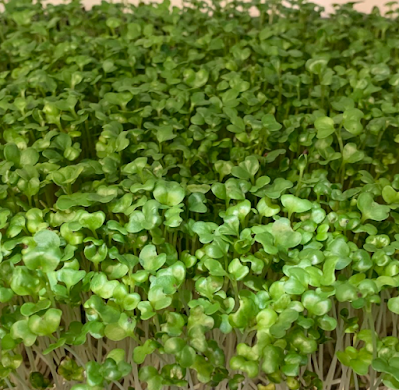
In recent years, microgreens have taken the culinary world by storm, not only for their vibrant colours and delicate flavours but also for their remarkable nutritional benefits. These miniature versions of vegetables and herbs are harvested at an early stage of growth, typically when they have developed their first true leaves. Among the plethora of options, broccoli, sunflower, daikon radish, Oregon giant peas (or green peas), alfalfa, yellow mustard, and red cabbage stand out to me as both easy to grow and packed with essential nutrients. Let's delve into the cultivation of these microgreens in a hydroponic setting and explore the health advantages they offer.
Broccoli Microgreens


Broccoli (Brassica oleracea var. italica) microgreens are rich in sulforaphane, a compound known for its potent anti-inflammatory and anti-cancer properties. They are also abundant in vitamins A, C, and K, as well as minerals like potassium and calcium.
I've been growing broccoli microgreens for about two years and have been getting amazing results. To grow them, soak them in water for 8-12 hours, sow the seeds densely in a growth tray, keep them moist, and ensure adequate sunlight once they spout. They typically reach harvest size in 7-14 days.
Check out some of the latest batches of broccoli that I've been growing.
Daikon Radish Microgreens


Daikon radish microgreens offer a peppery flavour (trust me, they can get quite spicy so don't eat too much in one meal) and are loaded with antioxidants such as sulforaphane and indole-3-carbinol. They are also a good source of vitamin C and fibre.
I recently started growing daikon radish microgreens and found them quite easy to grow. Soak them in water for 8-12 hours, sow the seeds densely in a growth tray, keep them moist, and ensure adequate sunlight ventilation. They grow very fast and can be harvested in as little as 5-7 days.
Check out some of my latest batches of daikon.
Oregon Giant Pea (or Green Pea) Microgreens

Oregon giant pea microgreens boast a sweet, delicate flavour and are packed with protein, fibre, and vitamins A and C. Green pea microgreens also fall into this category as they are very similar in both looks and texture.
Growing Oregon giant pea and green pea microgreens is a bit more challenging as they are larger and require more effort to maintain the growth environment while germinating. To grow them involves soaking the seeds overnight (8-12 hours), spreading them evenly in a tray, and maintaining the ideal growth environment for germination. Harvesting typically occurs within 7-14 days.
Sunflower Microgreens

Sunflower microgreens are prized for their nutty flavour and crunchy texture. They are an excellent source of protein, vitamin E, and essential fatty acids.
Growing sunflower microgreens involves soaking the seeds overnight, spreading them evenly in a tray, and providing ample sunlight. Harvesting can occur within 7-14 days, depending on desired maturity.
Alfalfa Microgreens

Alfalfa microgreens are known for their mild, slightly nutty flavour and are a powerhouse of nutrients, including vitamins K and C, folate, and calcium.
To grow alfalfa microgreens, spread the seeds evenly on a tray, mist them regularly, and provide indirect sunlight. Harvesting can begin in as little as 7 days.
Yellow Mustard Microgreens

Yellow mustard microgreens add a spicy kick to dishes and are abundant in antioxidants, vitamins A and C, and minerals like calcium and iron.
Growing yellow mustard microgreens involves densely sowing the seeds, keeping the soil moist, and providing ample sunlight. They can be harvested in 7-14 days.
Red Cabbage Microgreens

Red cabbage microgreens are prized for their vibrant colour and peppery flavour. They are packed with antioxidants, vitamins C and K, and sulforaphane.
To cultivate red cabbage microgreens, sow the seeds densely in a tray, keep the seeds moist, and provide indirect sunlight. Harvesting typically occurs within 7-14 days.
The Health Benefits of Microgreens
Microgreens are not only flavorful additions to dishes but also offer a concentrated dose of nutrients. Despite their small size, they often contain higher levels of vitamins, minerals, and antioxidants than their mature counterparts. Studies have shown that regularly consuming microgreens can contribute to improved digestion, enhanced immune function, and reduced risk of chronic diseases such as heart disease and cancer.
Moreover, microgreens are incredibly versatile and can be incorporated into a wide range of dishes, including salads, sandwiches, smoothies, and garnishes. Their delicate texture and vibrant colours add visual appeal to any culinary creation.

In conclusion, growing microgreens such as broccoli, sunflower, daikon radish, Oregon giant peas, alfalfa, yellow mustard, and red cabbage at home is not only simple but also rewarding. By harnessing their nutritional benefits and culinary versatility, you can elevate both the flavour and healthfulness of your meals. So, why not embark on a microgreen gardening journey today and reap the abundant rewards for your well-being and palate alike?

Comments
Post a Comment